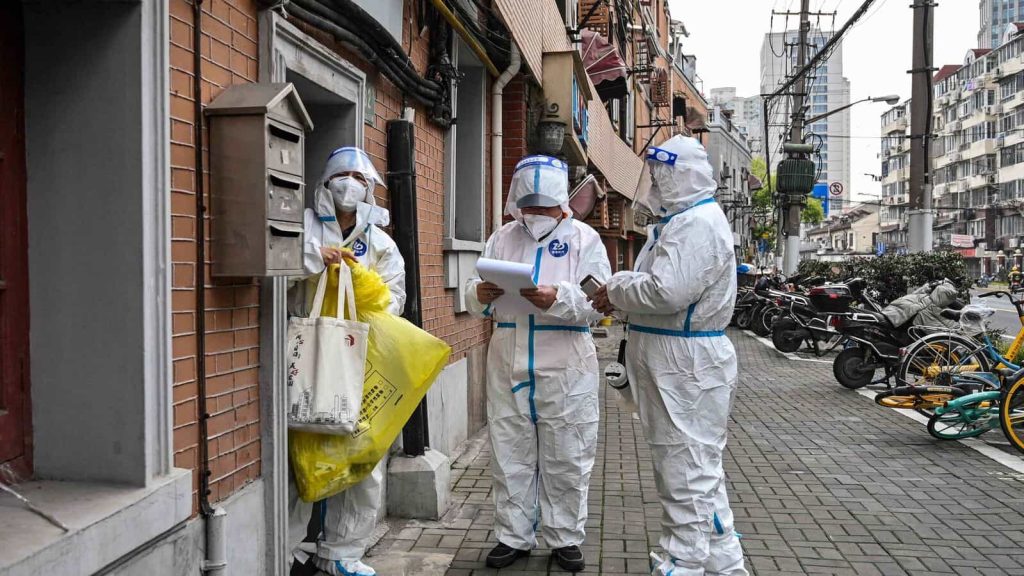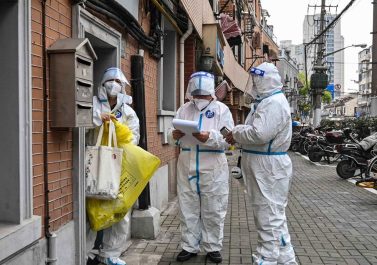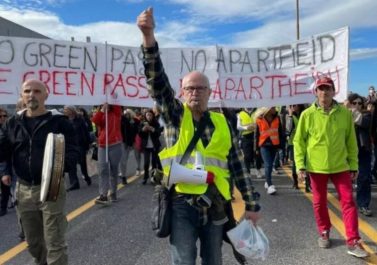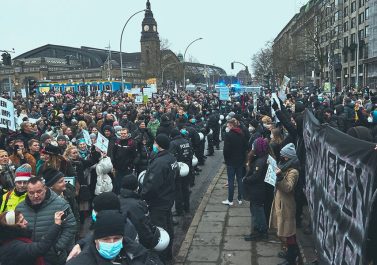
Hello!
I would like to share two English articles with you that show how migrant workers are faring in the lockdown. The first article features four short reports about workers who are in lockdown in dormitories or trucks. These reports show, as you would expect, loss of income, lack of food supply, but also the lack of control of quarantine requirements. In one photo you can see that there is supposedly a seal, a lockdown sticker over the door and door frame of Xu’s dormitory – see the first interview. They’re not supposed to be able to leave the sealed dormitory, but apparently they can get out and eat in the canteen. I find it remarkable that as a semi-skilled worker he earned 7000 RMB (currently over 1000 Euro) a month in the auto parts factory, but that in Shanghai living costs are so high that even with such a relatively high wage he doesn’t manage to save anything.
The second article is about migrant workers who are hired as COVID workers in quarantine centres or for mass testing. Hourly wages are sometimes very good, but people complain about poor treatment, fraud, etc., and again, COVID measures for those who test positive are not as strictly observed as they officially should be.
The Chinese population is getting tired of COVID, the healthcare system is in a poor shape, while the virus itself gets more contagious… The longer the pandemic drags on and the more comprehensive the lockdowns become, the worse the zero-COVID policy scales. But how will it end?
The current Corona outbreak in Shanghai began in early March. Gradually, parts of the metropolis of 26 million people have been placed under lockdown, and since early April, virtually the entire city is locked down. This mainly means house arrest, with very many residents not allowed to leave their apartments or apartment buildings. Asymptomatic positive cases, suspected cases and first- and second-degree contacts are forcibly isolated in quarantine camps. In exhibition halls, hundreds of people share a handful of porta-potties, sleeping on wooden cots, and only the lucky ones among them have hot water or can even shower. Daily infections range from 15 – 30,000, sometimes falling, sometimes rising. The infection figures are glossed over and falsified. The official number of infected in Shanghai, about 500,000 since March, may be half right (or falsified by a factor of 10-100), but the numbers on deaths are bullshit in any case. On the Internet I found a table according to which in Shanghai already more than 130 people have died as a result of the lockdown measures – compared to the approx. 100 official Corona deaths. But despite the severity of the lockdown, there is still no end in sight.
Aside from Shanghai, which is China’s most important economic metropolis, about 80 of China’s 100 largest cities are still in lockdowns of varying severity. Some of these are even preventative lockdowns, with no local infections – for example, public transport in Wuxi has been suspended as a precaution. The lockdowns are resulting in homelessness and mass wage losses, regular food shortages, sometimes severe medical emergencies and even deaths. Triage and testing is done by workers who haven’t received medical training. People are literally fenced into their apartments or apartment buildings. These are mad, tragic, panic-stricken scenes like those we witnessed in Wuhan two years ago.
The background of this absurd and inhuman situation is the zero-COVID policy. In Germany, the goal was to ‘flatten the curve’. For this goal, it does not matter whether individual infected persons violate the quarantine requirements, because it is a matter of average behavior. The goal was to slow the spread rather than to cut off all chains of infection. But if the goal is zero or close to zero new infections, then every infection chain must be broken and everyone must be forced to quarantine – because anyone who breaks the quarantine rules could trigger the next wave.
On the internet, many people are calling for home quarantine and permission to stay at home if symptoms are mild. Not only would this be much more humane, but it would also allow the collapsed healthcare system to focus on cases that truly need medical attention. But with isolation in one’s own home without strict monitoring, there would surely be frequent breaches of the quarantine and a return to zero-COVID would be illusory. So the suffering in Shanghai is a direct result of the zero-COVID strategy.
After the lockdown in Wuhan in early 2020, zero-COVID initially seemed relatively successful in China. But vaccination campaigns didn’t prioritise groups of people with a particular medical risk factor, but rather focused on people who came into contact with people or goods from abroad at ports, airports or border crossings. This led to low vaccination rates among the elderly. Nearly five million people over 60 live in Shanghai; significantly fewer than half of them are fully vaccinated. China is a no-vaxxer paradise! Everywhere you have to show a health code and are quarantined if you come from the wrong administrative district, but no one asks about your vaccination status. Only after the disaster in Hong Kong, where the vaccination rate among the elderly is even lower, have new vaccination campaigns been launched. Moreover, studies from Singapore show that the Chinese vaccines have only one-fifth the protective effect against severe courses compared to the Biontech agent.
For more than two years, Chinese propaganda has celebrated lockdowns and zero-COVID as the superiority of the Chinese system over the West. I have personally experienced the schadenfreude and sense of superiority this generates. Infected people are treated like criminals, recovered people not infrequently like lepers who have their tenancy or employment terminated. A small minority of infected people have to pay a very high price so that the vast majority can go about their daily lives relatively unmolested. As long as this minority was very small, hardly anyone got upset about their inhumane treatment. Their complaints were censored, because rabid nationalists saw them as treason against the fatherland.
Once you adopt a zero-COVID strategy it is very difficult to change course, and not only for ideological reasons. It would also require a rapid and significant increase in vaccination rates among at-risk groups. In order to be able to replace forced isolation and exclusion by a flexible policy, so that public life would be reduced or opened up depending on local infection rates and health system utilisation, a million-strong army of bureaucrats, COVID workers, security guards and cops would have to be retrained virtually overnight.
After years of self-praise for Chinese superiority, the president Xi would need a good propaganda story for all of this. But since he is soon to be named the great leader for life, so much risk and change of direction comes at a bad time. The national health authority declares that there is no alternative to continuing the zero-COVID policy and justifies this by repeating for a year now that the vaccination rate must be increased first and that, otherwise, the Chinese health system would collapse. China has bought itself time with tough lockdowns, but wasted it, instead of preparing itself for the next wave by vaccinating and expanding the healthcare system. So they continue to tighten the screw, ‘hard lockdown’ until they win. For a few days now, we’ve been seeing more videos of fence lockdowns, where six-foot-high garden fences are erected in front of home entrances at night.
Brutality
Again, there are reports of self-organisation and neighborhood mutual aid, but much less than in Wuhan in early 2020, and these reports are overshadowed by the commercialisation of social relations and by profiteering. Apartment complexes buy food in bulk, organized through community leaders, not a few of them in higher social positions. Delivery companies raise the price of food three to five times. Authorities prohibit supermarkets from selling directly to individuals; purchases may only be made as a group. Food deliveries rot in front of building entrances because property managers enforce their monopoly on supply. A logistics worker tells us that he can make 2000 RMB and more a day, three to six times the usual. An article from the state press praises neighborhood assistance and describes examples of ‘news workers’: some volunteers in an apartment complex take on the task of combing through the news and official decrees for what is relevant to that apartment complex about the supply situation, PCR mass tests, and any tightening or loosening. This is necessary because public officials hide behind red-tape jargon for fear of accountability, mistakes and punishment.
People are disregarded, pushed, beaten, kicked, panicked, locked into apartments like a prison cell by the ‘Dabai’, which is the soft-sounding name for the men and women in white protective suits. But the Dabai themselves are just as disrespected and deceived as those people who they incarcerate. In addition to unemployed migrant workers, also community workers and local residents are recruited as Dabai. The former are employed by local authorities as a kind of semi-skilled social workers and are forced to participate. Some local residents volunteer both out of boredom or fear of food shortages, and because there are three daily meals for Dabai. Of these, no one is 100 percent behind the measures. I have heard from various sources that hardly anyone among the medical staff in Shanghai is convinced of the current zero-COVID strategy either. But although the Dabai don’t really stand behind the measures, they still seem to care little about the suffering they have helped to cause. In countless videos of Dabai imprisoning or fencing off residents and residents demanding information about the meaning, purpose and authorisation, the Dabai ignore such questions and cries for help and carry on silently and stoically.
I wouldn’t be surprised if there is also a bit of indirect revenge for the recklessness of the Dabai in the general recklessness in everyday life. Car drivers are pretty inconsiderate anyway. But so are e-moped drivers. Whether I’m walking on a sidewalk or crossing a pedestrian light when it’s green, I always have to be careful not to get hit by the e-mopeds (food delivery drivers, cargo tricycles …), which has happened to me several times. Many not only take the right of way and give way only at the last moment, but they do not give way at all and do not care because it hurts the pedestrian more. My subjective impression is that recklessness on the road among two-wheelers has gotten worse in recent years, which is only one indicator of general social tendencies.
An interview (in Chinese) with someone who spent ten days in a quarantine camp illustrates both the ruthlessness in the camps and the lack of everyday empathy of Shanghai’s middle class toward workers. The interviewee tested positive on the 4th of April, then was put in the camp on the 11th of April without the slightest symptoms, when his tests had long been negative. Complete bullshit! He describes how an old man with an eye condition goes blind in the midst of hundreds of people because no eye medicine is provided to him. Later, the interviewer explains that the orderlies and security guards can actually be quite human, just overwhelmed. He chats with the guards, who ask him what he does for work. To his answer that he produces computer games, they reply that he certainly earns a lot, 7,000 or 8,000, right? The interviewer and the interviewee laugh at this, because they know, as do all the listeners, that the corresponding incomes in Shanghai are much higher than the gatekeepers imagine (certainly five to ten times as much). The middle class, which has just been complaining about the lack of compassion for the inmates of the quarantine camps, has only laughter for ignorant workers who do not even suspect the true extent of social inequality.
The inertia of the helpless
The uprising against the lockdown fails to materialise. Most complaints are voiced only online or in small groups of residents. In addition, there are individual attempts to secretly evade mass testing and conceal symptoms or test results. The only major spontaneous demonstration with 500 people that I have heard of was by tenants who were to be evicted from their apartments to make room for quarantine stations. In other words, the assholes from the Shanghai bureaucracy again claiming that throwing 500 tenants out on the street at a time when it is virtually impossible to find a hotel room or any other place to stay is to fight the pandemic! There was desperate protest against this from the affected tenants. But apart from online outrage, I have seen nothing of solidarity, no solidarity demos, no solidarity sit-ins….
Online you always see the same pattern: in numerous recordings of phone calls to health departments and local authorities, the authority representatives or so-called volunteers first try to brush off the callers (who, for example, have a medical emergency at home); when this fails, they break down in tears and whine that they are helpless, too, and that everything is so hard for them, too, and that their own superiors would let them down, too…. 无能为力,wunengweili, helpless, powerless… is the keyword you hear everywhere. Even a small protest video that is making some noise right now boils down to this phrase. China has become the homeland of the helpless and powerless, 无能为力国家.
Zhong Nanshan is China’s leading medical spokesperson, who has been staging the fight against COVID alongside Xi’s people’s war against the virus from the early days of the Wuhan outbreak. Posters of him with slogans about fighting the pandemic hang on every advertising pillar. He recently wrote in an article that zero-COVID can only be a temporary strategy and that the country will have to open up again sooner or later – the Chinese version of the article has been deleted. At the same time, it is obvious that the zero-COVID strategy cannot continue for much longer. People are more afraid of the quarantine camps than of the virus. Adherence to social distancing and hard lockdowns were enforced from the beginning with the fear of the virus. As this fear dwindles, so does compliance with the measures and thus their effectiveness. At the same time, the workload is increasing with the current infection rates. Doctors and nurses are being pulled out everywhere, and the barely trained Dabai are increasingly likely to stop giving a damn about zero-COVID: they experience firsthand how little it is taken seriously when they infect themselves in the dormitory.
In one video, a 94-year-old woman who tested positive fights back with a broom against six people in white suits who try to drag her into a quarantine camp. She beats them off and is able to stay in her apartment! It’s obviously not that hard to resist the measures, but few dare. You see videos of individuals breaking out of enclosures – and then being caught and hauled away by cops in white suits. But collective action? Would it be so difficult to break open the gate and shop in the supermarket together, a simple solution to the supply problems! Would it be difficult to leave the quarantine camp together?
Why isn’t there more trouble in Shanghai? When I discuss this question with my anarchist friends here, all they can think of is that Chinese society is blatantly atomised. It is precisely this isolation, powerlessness and lack of empathy that make their political practice in China so difficult. The big waves of strikes were a long time ago. A friend says he deliberately devotes little time to the events in Shanghai because he finds it unbearable. Afterwards, I have the impression that I am only now grasping the social challenge that my friends are facing all the time. They are not surprised, I am!
I had thought the scenes of brutal and irrational lockdowns at the beginning of the pandemic two years ago were an extraordinary, one-time event, and I had partly explained them with the general panic – I panicked then, too. That was wishful thinking.
The current lockdowns show that irrational, inhumane quarantine decrees and their brutal, stoic and merciless enforcement are permanent institutions of Chinese society – as are their helpless acceptance and the absence of collective resistance. Similarly, the social isolation, the individual feelings of powerlessness, the tendency to gloss over one’s own suffering and over the propaganda lies, and the ruthlessness toward others are an essential part of learned social behaviour. For years and decades, the Dabai workers were treated inhumanely and like disenfranchised people, why should they do it any differently now towards a few middle class residents?
I did not imagine that everyday ruthlessness had such implications, nor do I have any theoretical explanation for it. If one tried to explain this simply as capitalist business-as-usual, I would have to grin – I used to be that naive.
What does this mean for social struggles and political action? The question inevitably makes me think that those who complain about wage theft and overtime one moment find nothing wrong with dragging old and sick people across the floor like sacks of flour the next. What else can one do there except write ‘accident reports’ like this letter? What hopes can one then have for collective demands for better working conditions if even such drastic deteriorations in living conditions do not lead to collective protest?
The absurd and unnecessary suffering which is carried out with indifference in Shanghai (and in other lockdowns) and accepted whiningly, but without resistance, is a sad indicator of what kind of social dynamics we can expect for the coming years (or even decades?)
On the other hand, this silent behaviour of the helpless generates social change. Truck traffic in Shanghai is at 18 percent of last year, in the neighbouring province at about 60, in all of China at about 75. Hardly anyone wants to drive a truck anymore and end up in quarantine. In the next three years, industry in China will be lacking about 30 million factory workers, because no one wants to work there anymore. Freighters are jammed in front of Shanghai, but the exact extent of the economic consequences of the lockdowns is kept a state secret…
In the crisis the state is expanding even further into the economy. State-owned real estate companies are to prop up the slipping real estate market, state investment funds the collapsing stock market. The new, state-organized private pension insurance is supposed to divert private savings and investments into state pension funds. Local governments are instructed to bang out most of the annual debt allowance already in the first half of the year and to build even more bridges, roads and data centers… To ensure social stability, the bubble is pumped up further. Instability is bound to grow out of this. But the longer I live in this country, the clearer it becomes to me how little I am able to speculate about how and when this will ever take hold.
Greetings,
Yours, Gustav



